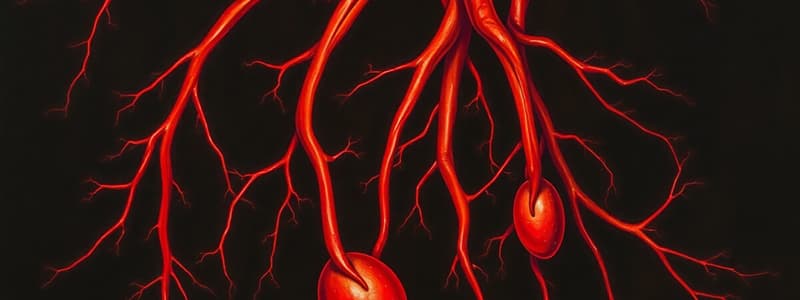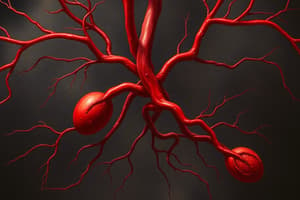Podcast
Questions and Answers
What is the main function of capillaries?
What is the main function of capillaries?
- Store blood
- Regulate blood pressure
- Transport oxygenated blood
- Facilitate exchange between blood and tissues (correct)
Veins carry blood away from the heart.
Veins carry blood away from the heart.
False (B)
What is the primary function of elastic arteries?
What is the primary function of elastic arteries?
- They push blood from the heart during ventricular diastole. (correct)
- They distribute blood to the capillaries.
- They carry blood back to the heart.
- They facilitate gas exchange in tissues.
What are the three layers of blood vessels called?
What are the three layers of blood vessels called?
The arterioles branch into tissues and become __________.
The arterioles branch into tissues and become __________.
Vasodilation refers to the contraction of smooth muscle fibers in blood vessels.
Vasodilation refers to the contraction of smooth muscle fibers in blood vessels.
What are the two main components that make up the tunica externa of blood vessels?
What are the two main components that make up the tunica externa of blood vessels?
Which layer of blood vessels is composed of smooth muscle and connective tissue?
Which layer of blood vessels is composed of smooth muscle and connective tissue?
The network of tiny vessels servicing large blood vessels is called the __________.
The network of tiny vessels servicing large blood vessels is called the __________.
Vasodilation results in an increase in the lumen diameter.
Vasodilation results in an increase in the lumen diameter.
What is the primary purpose of the tunica externa in blood vessels?
What is the primary purpose of the tunica externa in blood vessels?
Match the blood vessel type with its description:
Match the blood vessel type with its description:
Match the following blood vessel structures with their functions:
Match the following blood vessel structures with their functions:
What type of blood vessel carries blood away from the heart?
What type of blood vessel carries blood away from the heart?
Veins are responsible for carrying oxygenated blood away from the heart.
Veins are responsible for carrying oxygenated blood away from the heart.
What is the primary function of capillaries in the circulatory system?
What is the primary function of capillaries in the circulatory system?
The two primary processes involved in blood vessel diameter changes are ______________ and ______________.
The two primary processes involved in blood vessel diameter changes are ______________ and ______________.
Match the following layers of blood vessels with their descriptions:
Match the following layers of blood vessels with their descriptions:
What regulates the resistance in blood vessels?
What regulates the resistance in blood vessels?
Capillaries are large-diameter vessels that allow for high velocity blood flow.
Capillaries are large-diameter vessels that allow for high velocity blood flow.
Define a blood reservoir and its importance in the cardiovascular system.
Define a blood reservoir and its importance in the cardiovascular system.
Flashcards
Capillary function
Capillary function
Capillaries facilitate the exchange of substances between blood and tissues.
Capillary structure
Capillary structure
Capillaries are very small in diameter with thin walls for efficient exchange.
Venule function
Venule function
Venules are small veins that collect blood from capillaries.
Vein function
Vein function
Signup and view all the flashcards
Tunica layers
Tunica layers
Signup and view all the flashcards
Tunica externa function
Tunica externa function
Signup and view all the flashcards
Vasodilation/vasoconstriction
Vasodilation/vasoconstriction
Signup and view all the flashcards
Tunica interna function
Tunica interna function
Signup and view all the flashcards
Blood Vessel Loop
Blood Vessel Loop
Signup and view all the flashcards
Arteries
Arteries
Signup and view all the flashcards
Arterioles
Arterioles
Signup and view all the flashcards
Elastic Arteries
Elastic Arteries
Signup and view all the flashcards
Muscular Arteries
Muscular Arteries
Signup and view all the flashcards
Capillaries
Capillaries
Signup and view all the flashcards
Venules
Venules
Signup and view all the flashcards
Veins
Veins
Signup and view all the flashcards
Elastic artery function
Elastic artery function
Signup and view all the flashcards
Vasa vasorum
Vasa vasorum
Signup and view all the flashcards
Tunica externa composition
Tunica externa composition
Signup and view all the flashcards
Smooth muscle relaxation
Smooth muscle relaxation
Signup and view all the flashcards
Blood vessel extensibility
Blood vessel extensibility
Signup and view all the flashcards
Study Notes
Blood Vessels and Hemodynamics
- Five main types of blood vessels exist: arteries, arterioles, capillaries, venules, and veins.
- All form a large interconnected loop.
- Arteries and arterioles carry blood away from the heart.
- Large elastic arteries carry initial blood from the heart.
- Branch into muscular, medium-sized arteries.
- Small arteries branch into arterioles.
- Capillaries facilitate exchange between blood and tissues.
- Arterioles branch into capillaries in tissues.
- Thin walls facilitate exchange.
- Veins and venules return blood to the heart.
- Capillaries merge into venules.
- Venules merge into larger veins that return blood to the heart.
Blood Vessel Structure
- Blood vessels have three layers called tunics:
- Tunica interna: innermost endothelial lining.
- Tunica media: middle smooth muscle layer.
- Tunica externa: outermost connective tissue layer.
- The tunica interna lines blood vessel walls.
- Provides thin endothelial lining in direct contact with blood.
- Facilitates exchange by diffusion.
- Provides smooth surface for blood flow.
- The tunica media varies between vessel types.
- Contains smooth muscle and elastic fibers.
- Mediates vasoconstriction and vasodilation.
- The tunica externa varies between vessel types.
- Mostly collagen and elastic fibers.
- Contains many nerves.
- Support larger blood vessels (vasa vasorum).
Capillary Beds
- Capillaries are the smallest blood vessels (5-10 μm diameter).
- Branch extensively, supplying all body cells with nutrients and removing waste.
- Three mechanisms of capillary exchange: diffusion, transcytosis, and bulk flow.
- Diffusion: movement of substances due to concentration gradients.
- Transcytosis: movement of large molecules through cells (e.g. hormones, antibodies).
- Bulk flow: collective movement of large amounts of molecules from high pressure to low pressure.
- Capillary beds have a unique structure.
- Lack both the tunica externa and media.
- Only endothelium and basement membrane for rapid diffusion.
- Many branches increase total surface area for exchange (capillary beds).
- Capillaries branch from metarterioles to 10-100 capillaries.
- Through capillaries, or through a thoroughfare channel to venules.
Venules and Veins
- Venules are thin-walled vessels that lose shape easily.
- Muscular venules can stretch.
- Veins change shape as they merge into larger vessels, but all are thin-walled.
- Contain valves to prevent backflow.
- Accumulate large blood volumes.
- Venous return, movement of blood from capillaries to the heart depends on skeletal muscle pump.
- The respiratory pump helps to compress veins during inhalation to increase venous return.
Blood Pressure
- Blood pressure (BP) is the hydrostatic pressure exerted by blood on blood vessel walls.
- Measured in mmHg.
- Affected by cardiac output, blood volume, and resistance.
- Systolic blood pressure is highest during ventricular contraction, while diastolic blood pressure is lowest during ventricular relaxation.
- Blood flows from high to low pressure.
Blood Flow
- Blood flow is the volume of blood moving through a given tissue per unit of time.
- Measured in mL/min.
- Cardiac output (CO) is the total blood flow.
- Perfusion is the extent of blood flow to particular areas.
- Many factors modulate blood flow.
- Resistance: friction between blood and vessel walls.
- Viscosity (thickness of blood).
- Length of blood vessels.
- Total cross-sectional area.
- The net filtration pressure (NFP) determines whether fluid volume in tissues changes.
Homeostatic Control
- Many factors regulate blood pressure.
- Hormones (e.g., ADH, ANP, epinephrine, norepinephrine).
- Autonomic nervous system (vasoconstriction/vasodilation).
- Physical changes(e.g., temperature, stretching), can also affect blood vessel diameter/tone and modulate blood flow.
Shock
- Shock occurs when insufficient blood flow leads to cellular damage.
- Different types of shock exist, including hypovolemic, cardiogenic, anaphylactic, neurogenic, and obstructive shock.
- Shock causes the body's physiological responses to compensate.
- The body attempts to release ADH, stimulate the RAA pathway and sympathetic nervous system.
Hypertension
- Hypertension is persistently elevated blood pressure.
- Idiopathic hypertension: no identifiable cause.
- Physiological causes: increased blood volume, increased vascular resistance, or increased cardiac output.
- Systemic and pulmonary circulations are the two main circulatory routes.
Studying That Suits You
Use AI to generate personalized quizzes and flashcards to suit your learning preferences.




